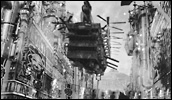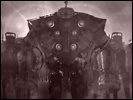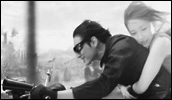Casshern
- Year
- 2004
- Original title
- kyashan
- Japanese title
- キャシャーン
- Director
- Cast
- Running time
- 141 minutes
- Published
- 28 June 2004



by Don Brown
Perhaps the day's not far off when desperate studio executives snap up the rights to classic kid's cartoon character Anpan Man, an anthropomorphic bean jam roll, and some hot young aesthete with a point to prove reinterprets the rosy-cheeked hero as a tragic Aristotelian avenger reborn from genetically modified yeast. Resurrected at the behest of an omnipotent multinational baked goods manufacturer by his creator Uncle Jam, Anpan Man will engage in a one-bun battle against the megalomaniacal Bacteria Man only to discover the batter-churning truth that he was in fact raised from the same dough as his nemesis. The turgid epic eventually concludes in an apocalyptic showdown that turns the world to croutons.
All flippancy aside, that's essentially what has happened with Casshern. This exhausting superhero morality play is an almost unrecognizable update of a minor animated series from Tatsunoko Pro made in the early 1970s. In a fairly straightforward saga of good vs. evil, powerful androids being developed by kindly scientist Azuma are brought to life by a freak bolt of lightning and instantly get in touch with their hatred for the human race. When they begin to terrorize mankind with an army of killer robots, Tetsuya, Azuma's son, valiantly volunteers to be reborn as the bionic hero Casshern in a desperate bid to save the world. He is joined by the cyborg dog Friender, who also helps him cut down on travel expenses by conveniently morphing into a spiffy jet from time to time.
Unfortunately for Friender, a victim of his own implausibility, his role has been reduced to a brief cameo appearance in the live-action remake. But just like the cast-iron pooch, only superficial traces of Casshern's original form remain in the new version. What was once a simple tale of a selfless hero taking on a clearly malevolent enemy has been transmogrified into a grandiose and convoluted statement on the destructive nature of humanity, embellished by a heavyweight cast of morally ambiguous characters and an all-consuming visual aesthetic that permeates every frame.
Now Azuma (played by Akira Terao) is a troubled geneticist obsessed with developing a cure for his angelic wife Midori (Kanako Higuchi)'s debilitating illness, a by-product of the environmental devastation wrought by fifty years of conflict between the Greater Eastern Federation and Europa. Their headstrong son Tetsuya (Yusuke Iseya), who can no longer bear to stand idly by while his friends go off to fight, enlists in the Federation army to the disapproval of his family and his beatific fiancé Luna (Kumiko Aso).
To alleviate the suffering of the ailing populace, Azuma has devoted himself to the development of a restorative "neo-cell" technology. His work is scorned by the Health Ministry, but secretly brought under the wing of the military by duplicitous businessman Naito (Mitsuhiro Oikawa) on behalf of the Federation's geriatric generalissimo Kamijo (Hideji Otaki), whose son (Hidetoshi Nishijima) is scheming to usurp his authority. Just as Azuma's grand experiment appears to be on the verge of producing results, a freak incident at the research facility causes a huge vat of regenerating body parts to reintegrate into humanoid form. The military reacts instinctively by annihilating the abominations, but a meager band of survivors manage to abscond to a deserted castle in the mountains with Midori as their hostage. After uncovering a dormant robot arsenal, the mutants' wild-eyed leader Brai (Toshiaki Karasawa) vows bloody revenge and unleashes an all-out war.
Elsewhere, during a traumatic tour of duty, Tetsuya is killed in combat. His body is returned to the desperate Azuma, who revives him using the neo-cell technology but the process renders his physiology highly unstable. Luna's military scientist father (Fumiyo Kohinata) comes to Tetsuya's aid by bestowing him with a prototype body armor, and with his newfound powers the physically and emotionally scarred hero sets out to save his mother and put an end to the carnage wrought by Brai and his minions. However, in the tenebrous world of Casshern, innocence is a scarce commodity, and even the righteous are not without sin...
It's almost as if first-time feature filmmaker Kazuaki Kiriya thought he was only ever going to get one shot at making a movie, and then proceeded to cram as many different ideas into it as he could. Hardly an industry insider, the U.S.-based photographer and sometime music video director jumped the queue to auteurdom apparently on the strength of his comprehensive vision for the project, and his hands-on approach encompassed editing, shooting and co-writing Casshern. Working with a reported budget of only 600 million yen (less than six million US$), Kiriya and his collaborators have transcended their financial limitations to produce a visually sumptuous fantasy that more than holds its own against comparable European and American productions.
The production managed to attract a stellar lineup of familiar veterans and popular new faces, and even has the luxury of casting the likes of Mayu Tsuruta (Owl's Castle) and the late Tatsuya Mihashi (Not Forgotten) in minor roles. The tone of the acting varies from character to character: Iseya smoulders with internal anguish, while Karasawa invests his overripe villainous spiel with a Shakespearian weight. But even with such an impressive array of reliable talent on board, discussion of the quality of the performances is virtually moot. The real stars of the show are Kiriya, production designer Yuji Hayashida, visual effects supervisors Toshiyuki Kimura and Koji Nozaki, CG supervisor Haruhiko Shono, and the rest of the team that has given Casshern its painstakingly detailed look. Every frame has been so meticulously designed that the sheer volume of visual information sometimes becomes a chore to process. Consequently, the density of the film's imagery is both its greatest strength and its most overwhelming flaw.
It's also yet another movie of late to adopt the retro sci-fi look, including Innocence, Steamboy, and the American film Sky Captain and the World of Tomorrow. As with the latter movie, most scenes have been digitally manipulated either partially or in their entirety, which has a powerful initial impact that gradually distances the viewer from the human element of the story as it wears off. Nevertheless, Casshern represents a massive technical achievement, one even more remarkable when you consider that the gargantuan workload was largely done by a sweatshop of young CG artists, who toiled almost around the clock on PCs assembled from spare parts procured from electronics mecca Akihabara.
It's not a totally binary affair though; there's even room for a bit of cute stop motion animation and home video-style footage. Although it may appear out of step with the overall look of the film, this isn't a total departure from its intermittently sentimental tone. Where it really lays it on too thick is a montage sequence that includes actual war footage, a great deal of it instantly recognizable to anyone who's watched television news in the last fifty years. Probably the most blatant artistic conceit in the whole film, it achieves the opposite of its intended effect by emphasizing its shallowness; a symptom of trying to be too showy when a more subtle approach would have paid greater dividends. This is especially true in some of the action sequences, where choppy editing and optical overload sometimes detracts from their fluidity.
Kiriya's music industry connections, including million-selling pop singer and spouse Hikaru Utada, were possibly another factor in getting the film off the ground. This would be confirmed somewhat by the soundtrack CD, which features a separate disc of songs "inspired" by the film, many from high-profile musicians that have worked with Kiriya in the past. The score, while not inherently unpleasant, runs incessantly at a low level throughout Casshern's entire duration like designer elevator music. This becomes particularly grating during scenes when a little silence would have gone a long way, and its constant presence coupled with the lush art direction occasionally makes you feel as if you're watching an anthology of Kiriya's music videos.
Depicting a totalitarian industrialist future which is strikingly evocative of what may have happened if the Axis powers had won World War II and Japan had accomplished its Greater East Asian Co-Prosperity Sphere, Casshern attempts to pack a whole shopping list of earnest issues including pollution, scientific ethics, ethnic genocide and war crime into what is ostensibly a special effects-driven event flick. As a result, the story offers a great deal more to chew on than that of your average CG spectacular in the rare moments when the visual onslaught lets up a little, but the convoluted strands of plot entangled around its unsophisticated anti-war message make for sometimes unnecessarily confusing viewing. The characters are painted in shades of grey so thin that almost everyone is guilty of some crime, and not even the innocent escape punishment, which gives Casshern the dubious distinction of being perhaps the most unrelentingly austere and humorless superhero film of all time.
Considering the recent success of similarly pessimistic glimpses of the future such as Battle Royale and Dragonhead, perhaps we are witnessing the birth of a new, uniquely Japanese mutation: the unapologetically nihilistic commercial blockbuster.